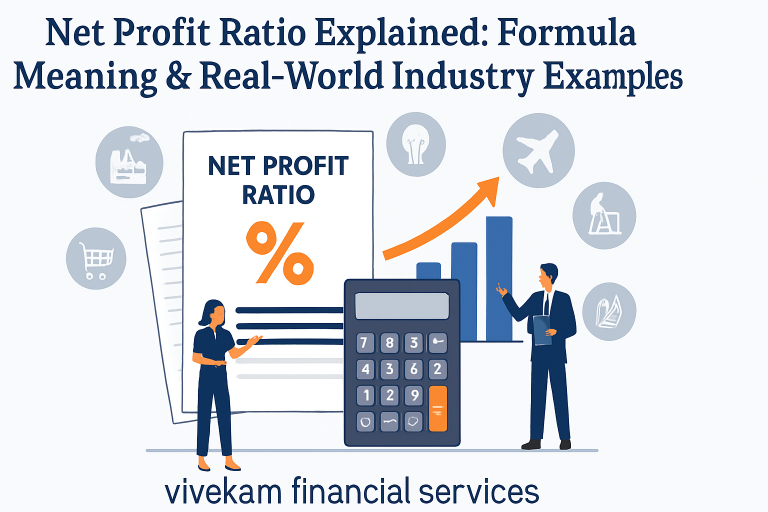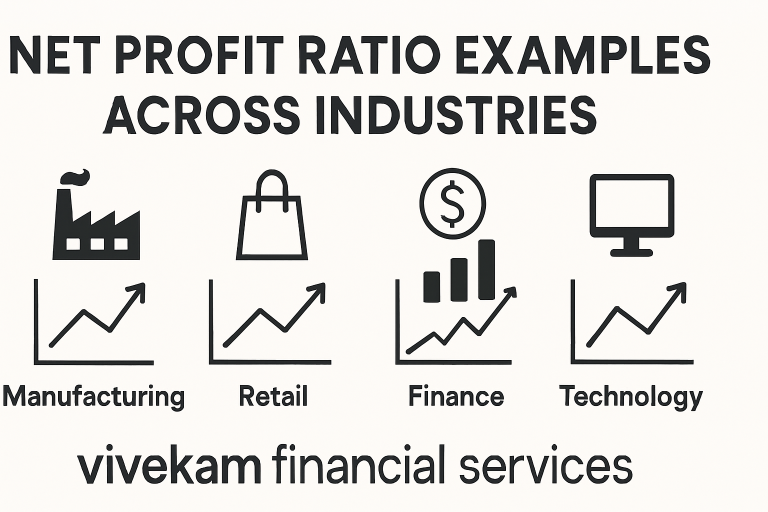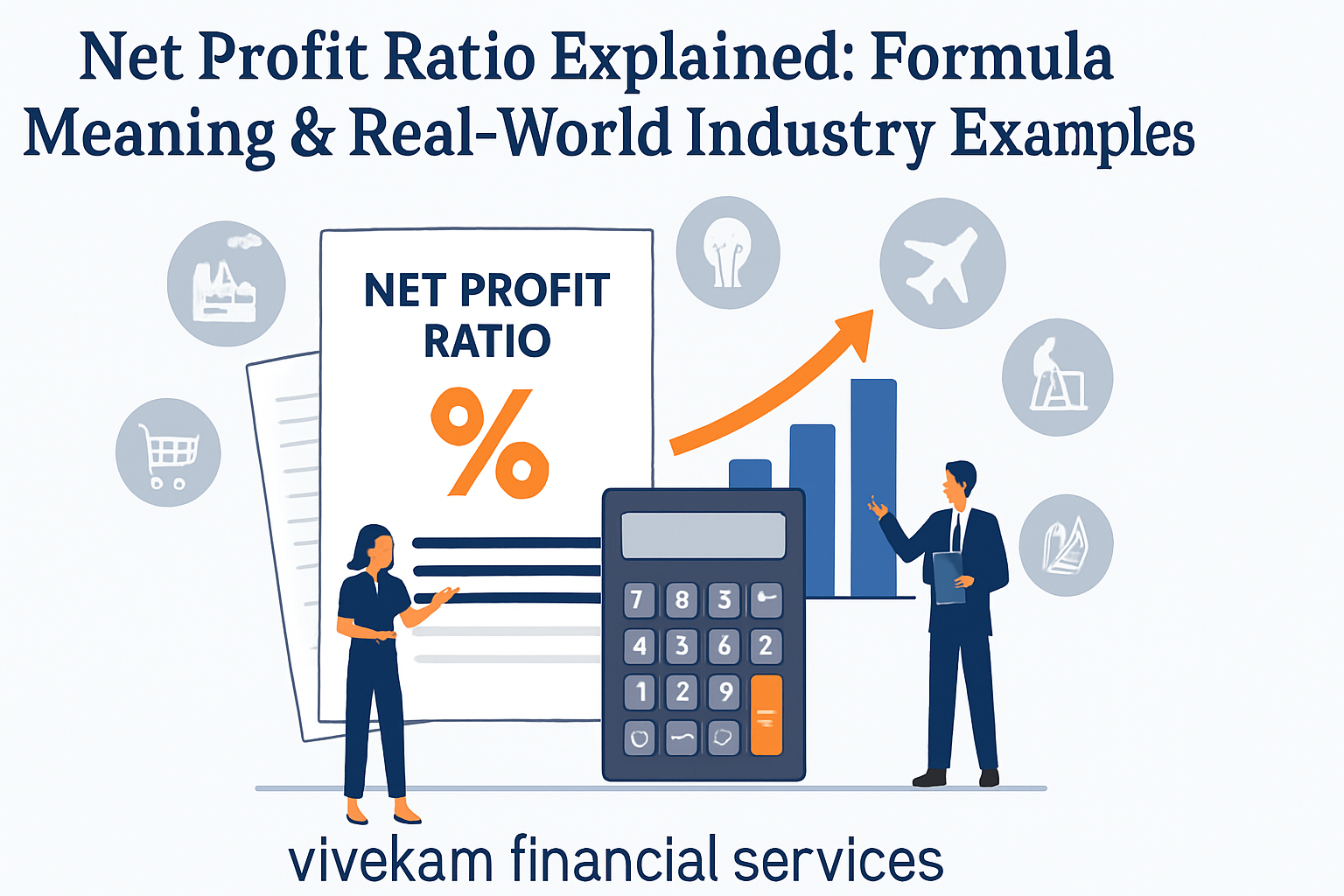Net Profit Ratio Explained: Formula, Meaning & Real-World Industry Examples

Introduction: Why Net Profit Ratio Matters
Why do two businesses with the same sales numbers end up with completely different bottom lines? The answer often lies in the net profit ratio.
Sales figures might look impressive, but they don’t always reflect true financial strength. Expenses, taxes, and interest can quietly eat away at revenue. The net profit ratio (NPR)—sometimes called the net profit margin—cuts through the noise and shows how much of your revenue actually stays in your pocket as profit.
Whether you’re a business owner, investor, or student of finance, understanding this ratio is crucial. In this guide, we’ll explore the concept, formula, importance, advantages, disadvantages, and industry-specific examples of net profit ratio.
What is Net Profit Ratio?

The net profit ratio is a financial metric that measures how much of a company’s net sales turns into net profit after deducting all costs. In simple terms:

For instance, if a business generates $200,000 in net sales and records $40,000 in net profit, its net profit ratio is 20%. That means for every $1 of revenue, the company retains $0.20 as profit.
Net Profit Ratio Meaning in Accounting
From an accounting perspective, the NPR provides insight into overall efficiency. A high net profit ratio signals effective cost management and healthy financial performance. A low ratio, on the other hand, could indicate inefficiencies, rising expenses, or poor pricing strategy.
Because it reflects the final bottom line, the NPR is often used to compare businesses across industries or track performance trends over time.
Understanding Profitability Metrics
Difference Between Gross Profit and Net Profit
- Gross Profit = Revenue – Cost of Goods Sold (COGS)
- Net Profit = Gross Profit – All operating expenses, interest, and taxes
Gross profit highlights how efficiently a company produces goods or services, while net profit reveals the true financial picture after all obligations are settled.
Net Ratio vs Gross Profit Ratio
- Gross Profit Ratio: Focuses on production and direct costs.
- Net Profit Ratio: Measures total profitability, considering every expense.
Both are important, but the NPR is broader and more reliable for evaluating overall success.
Net Profit Ratio Formula Explained
The Formula
The standard net profit ratio formula is:
Net Profit Ratio= (Net Profit / Net Sales) x 100
Where:
- Net Profit = Gross Profit – Operating Expenses – Taxes – Interest
- Net Sales = Total Sales – Returns – Discounts
How to Calculate Net Profit Margin
Let’s calculate:
- Net Sales = $200,000
- Net Profit = $40,000
Net Profit Ratio=(40,000÷200,000)×100=20%\text{Net Profit Ratio} = (40,000 ÷ 200,000) × 100 = 20\%Net Profit Ratio=(40,000÷200,000)×100=20%
This means for every dollar of sales, the company keeps $0.20 as net profit.
Importance of Net Profit Ratio in Business

Why It Matters
The net profit ratio is vital for:
- Investors, who want to see how efficiently companies convert sales into profit
- Managers, who use it to track performance and set financial strategies
- Lenders, who analyze it to assess repayment ability
Limitations to Keep in Mind
While NPR is powerful, it has its limitations:
- Results vary widely between industries
- Depreciation and other accounting entries can distort figures
- It doesn’t reflect cash flow
Net Profit Ratio Examples Across Industries

Manufacturing Industry
Large manufacturers often report lower NPRs due to heavy investments in research, equipment, and labor. For example, a car manufacturer may earn billions in sales but show only a 6–8% NPR.
Retail Sector
Retailers typically operate on thin margins. Walmart, for example, has an NPR of just 2–3%, while luxury retail brands may enjoy margins as high as 15%.
Service Industry
Tech companies and service firms often achieve higher margins (20%+) because they have lower overhead and scalable operations.
Advantages and Disadvantages of Net Profit Ratio
Key Advantages
- Provides a clear snapshot of profitability
- Helps detect cost inefficiencies
- Useful for benchmarking against competitors
Common Disadvantages
- Sensitive to non-operational factors like interest or taxes
- Doesn’t show liquidity or cash flow
- Less effective when used in isolation
Factors Affecting Net Profit Ratio
- Cost Control – Rising operational costs directly lower the ratio.
- Pricing Strategy – Strong pricing power boosts profitability.
- Market Competition – Intense competition often forces companies to cut margins.
How Businesses Can Improve Their Net Profit Ratio
- Reduce Operational Costs → Streamline processes, outsource tasks, and use automation.
- Boost Revenue Streams → Upsell existing customers, launch new products, expand markets.
- Leverage Technology → Use AI, cloud systems, and analytics to optimize efficiency.
Net Profit Ratio vs Other Profitability Ratios
Net Profit Margin vs Operating Profit Margin
- Operating Profit Margin excludes taxes and interest.
- Net Profit Margin includes everything, making it the final measure of profitability.
Net Profit Ratio vs Return on Assets (ROA)
- NPR = Profitability relative to sales
- ROA = Profitability relative to assets
Both are valuable, but NPR is more sales-focused.
FAQs on Net Profit Ratio
Q1. What is net profit ratio in simple terms?
It’s the percentage of revenue that remains after covering all costs.
Q2. How do you calculate net profit ratio?
Divide net profit by net sales and multiply by 100.
Q3. Why is net profit margin important?
It shows how efficiently a company turns sales into profit.
Q4. What is a good net profit margin?
It depends on the industry, but generally, 10% or above is considered healthy.
Q5. What are the limitations of NPR?
It doesn’t reflect cash flow and can vary across industries.
Q6. How is the net profit ratio used in decision making?
It guides strategies on pricing, cost control, and investment.
Conclusion
The net profit ratio is a cornerstone of financial analysis. It tells the story of how much profit a company keeps after all expenses, taxes, and interest are paid.
By learning the formula, importance, limitations, and industry benchmarks, business leaders and investors can make smarter decisions. While no ratio is perfect, the NPR remains one of the most trusted tools for measuring profitability.







